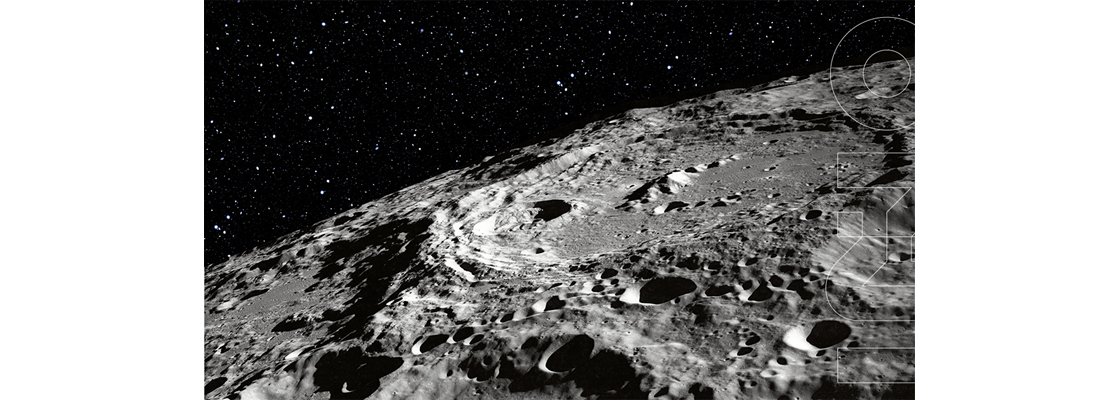Resume
NASA’s Trailblazer mission included the Lunar Thermal Mapper, equipped with infrared detectors developed by INO and the University of Oxford, for mapping lunar water and surface composition. Based on a gold-black coating and high-resolution design, these detectors are suitable for the measurement of extreme lunar temperatures and provide unprecedented data for future Moon and Mars exploration.
Since the dawn of time, the Moon has fascinated humanity. It has inspired myths, calendars, and poetry long before becoming a symbol of scientific ambition. On July 20, 1969, this fascination became reality when Neil Armstrong set foot on the lunar surface, marking a historic milestone in space exploration. Today, more than fifty years later, the interest in our natural satellite remains strong.
Why is it essential to better understand the Moon?
The Moon holds a unique place in our collective imagination. Beyond its symbolic significance, it is generating growing scientific interest, particularly for its potential in so-called critical materials, as well as its role as a stepping stone for long-duration crewed missions. In a context that, until recently, seemed almost unreal, gaining deeper knowledge of Earth’s only natural satellite has become imperative.
Understanding its composition and precisely locating lunar water has become a crucial challenge in preparing for the next stage of space exploration.
The Limits of Existing Space Technologies
Observing the Moon from a distance is no easy task. The technical challenges are numerous, and measuring instruments must meet several requirements:
- Measuring extreme thermal variations: on the surface, temperatures range from –165 °C to +125 °C.
- High-resolution imaging to maximize image quality.
- Weight and robustness constraints inherent to space launches.
How the Lunar Trailblazer Mission Was Born
An International Partnership
INO collaborated with the Planetary Experiments Group at the University of Oxford on the development of the Lunar Thermal Mapper, an infrared radiometer placed in orbit about 100 km above the Moon. Launched by NASA in February 2025 as part of the Lunar Trailblazer mission, this instrument was tasked with mapping water sources, as well as surface temperatures and the composition of the lunar soil.
Infrared Detectors Made in Québec
At the heart of the instrument are the infrared detectors designed by INO. Their secret lies in a unique expertise in depositing “black gold,” a material that ensures optimal absorption and exceptional sensitivity to thermal variations.
The black gold of the 110,000 pixels measuring 35 microns each — about half the diameter of a human hair — making up a camera sensor, was laser-cut to achieve the full resolution of 384 by 288 pixels. These detectors can thus capture the slightest thermal variations, even in the harsh environment of space.
Performance Tailored to Lunar Conditions
The infrared detectors developed by INO address three major challenges:
- Measuring extreme thermal variations: from –165 °C during the lunar night to +125 °C in full sunlight.
- Maintaining high spatial accuracy: essential for distinguishing local structures.
- Ensuring long-term reliability: thanks to a robust design validated by engineers at Oxford and NASA.
In addition, INO’s expertise in detector readout electronics was transferred to the Planetary Experiments Group, enabling the Oxford team to integrate it directly into the onboard system.
Toward a New Generation of Space Sensors
As space projects are often long-term endeavours, nearly three years passed between the completion of the work and the launch of Lunar Trailblazer.
Since the design of these detectors, INO has significantly improved the resolution of its cameras. The result: infrared sensors with seven times higher resolution (1024 × 768 pixels). Such image quality could pave the way for new lunar missions — and even ventures farther into the solar system. Without a doubt, the stars are aligning for a new chapter in space exploration!
As Rory Evans, Optomechanical Design Lead at Oxford, points out:
“This project will enable mapping the composition of the Moon with a level of detail never before achieved.”
With its cutting-edge infrared detectors, INO demonstrates that Québec expertise can contribute to major international space missions.
Frequently Asked Questions
What is black gold?
Black gold is a material with a raw gold density of less than 0.3%, characterized by a wide absorption band and low thermal mass. It is used in thermal sensors requiring a high degree of absorption and a fast thermal response.
What is the Lunar Thermal Mapper?
It is an infrared radiometer onboard NASA’s Lunar Trailblazer mission, designed to map water and the composition of the Moon.
What’s next for these sensors?
A new generation with 7 times higher resolution could be used in future missions to the Moon, Mars, and beyond.

